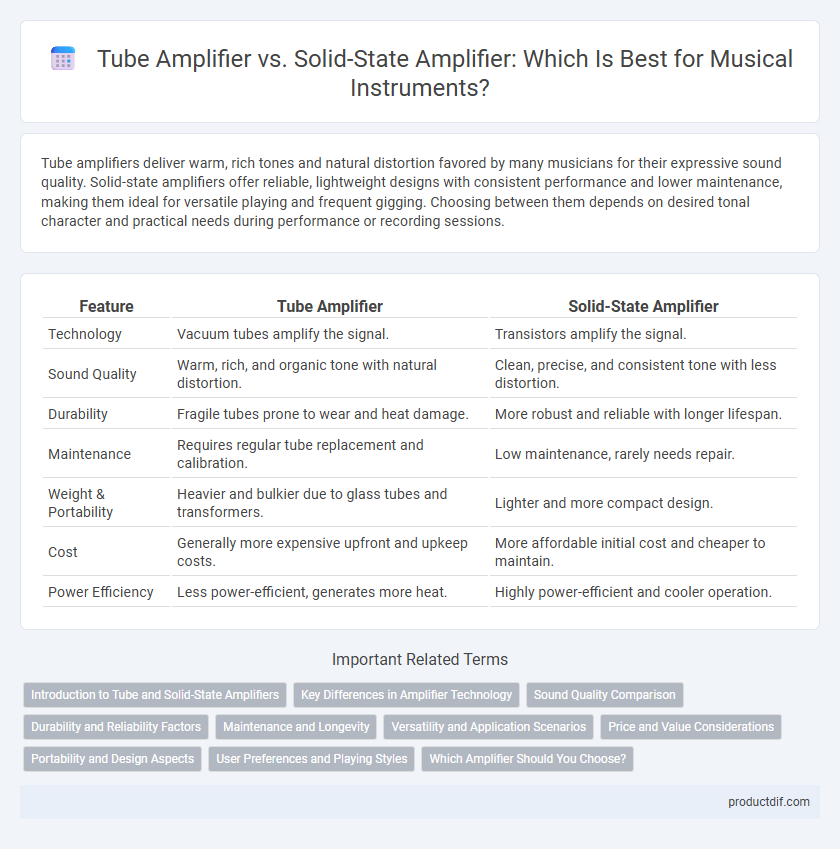Tube amplifiers deliver warm, rich tones and natural distortion favored by many musicians for their expressive sound quality. Solid-state amplifiers offer reliable, lightweight designs with consistent performance and lower maintenance, making them ideal for versatile playing and frequent gigging. Choosing between them depends on desired tonal character and practical needs during performance or recording sessions.
Table of Comparison
| Feature | Tube Amplifier | Solid-State Amplifier |
|---|---|---|
| Technology | Vacuum tubes amplify the signal. | Transistors amplify the signal. |
| Sound Quality | Warm, rich, and organic tone with natural distortion. | Clean, precise, and consistent tone with less distortion. |
| Durability | Fragile tubes prone to wear and heat damage. | More robust and reliable with longer lifespan. |
| Maintenance | Requires regular tube replacement and calibration. | Low maintenance, rarely needs repair. |
| Weight & Portability | Heavier and bulkier due to glass tubes and transformers. | Lighter and more compact design. |
| Cost | Generally more expensive upfront and upkeep costs. | More affordable initial cost and cheaper to maintain. |
| Power Efficiency | Less power-efficient, generates more heat. | Highly power-efficient and cooler operation. |
Introduction to Tube and Solid-State Amplifiers
Tube amplifiers use vacuum tubes to amplify sound signals, producing warm, rich tones favored by many musicians for their natural distortion and dynamic response. Solid-state amplifiers rely on transistors and semiconductors, offering reliable performance, lower weight, and greater durability with cleaner and more consistent sound output. Each amplifier type impacts the tonal characteristics and playing experience, influencing genres and styles from blues to rock and electronic music.
Key Differences in Amplifier Technology
Tube amplifiers utilize vacuum tubes to amplify the audio signal, producing warm, rich harmonics and natural distortion favored by many musicians for its musicality. Solid-state amplifiers employ transistors for amplification, offering greater reliability, lower maintenance, and typically cleaner, more precise sound reproduction. The choice between these technologies impacts tonal character, response dynamics, and amplifier weight, influencing a musician's preference based on style and performance needs.
Sound Quality Comparison
Tube amplifiers deliver warm, rich tones with natural harmonic distortion, favored for their dynamic response and musicality in electric guitar sound. Solid-state amplifiers offer clear, precise sound with consistent performance and lower noise levels, excelling in reliability and versatility across genres. Musicians seeking vintage warmth often prefer tube amps, while those valuing crisp clarity and durability opt for solid-state models.
Durability and Reliability Factors
Tube amplifiers feature fragile vacuum tubes prone to wear and require periodic replacement, impacting long-term durability. Solid-state amplifiers use transistors and electronic components that are more robust and less susceptible to damage from physical shock or heat. The reliability of solid-state amplifiers generally surpasses tube models due to lower maintenance needs and enhanced resistance to environmental stress.
Maintenance and Longevity
Tube amplifiers require regular maintenance such as tube replacements and bias adjustments to ensure optimal performance, while solid-state amplifiers demand minimal upkeep due to their durable electronic components. The lifespan of tube amps is generally shorter because tubes wear out over time, often lasting 3 to 5 years depending on usage. Solid-state amps typically offer greater longevity and reliability, often lasting decades with occasional cleaning and component checks.
Versatility and Application Scenarios
Tube amplifiers provide rich harmonic distortion and warm tones favored in blues, jazz, and rock, making them ideal for live performances and studio recordings that require dynamic response. Solid-state amplifiers deliver consistent, reliable sound with lower maintenance, suited for genres demanding clean, high-gain output like metal and pop, as well as portable setups and prolonged use. Musicians seeking versatility often combine both types to cover a broad range of tonal applications and amplification needs.
Price and Value Considerations
Tube amplifiers generally command higher prices due to their complex circuitry and vintage appeal, often ranging from $600 to over $3000. Solid-state amplifiers offer more affordability and durability, with quality models available between $200 and $1000, providing excellent value for budget-conscious musicians. The decision hinges on balancing the tube amplifier's warm, rich tonal quality against the solid-state model's cost-effectiveness and reliability.
Portability and Design Aspects
Tube amplifiers are typically heavier and bulkier due to glass vacuum tubes and robust transformers, making them less portable compared to solid-state amplifiers. Solid-state amplifiers feature compact, lightweight designs with durable solid components, enhancing ease of transport for live performances and travel. The rugged construction of solid-state amps also offers increased resistance to physical damage, supporting greater portability in various environments.
User Preferences and Playing Styles
Tube amplifiers deliver warm, rich tones favored by blues and rock guitarists seeking natural compression and harmonic distortion, enhancing dynamic playing styles. Solid-state amplifiers provide reliable, clean sound with consistent performance, appealing to jazz and metal players who prioritize clarity and precision. User preferences often hinge on genre and tactile response, with tube amps prized for expressive feel and solid-state amps for durability and low maintenance.
Which Amplifier Should You Choose?
Tube amplifiers deliver warm, rich tones favored by blues and rock guitarists for their dynamic response and natural distortion. Solid-state amplifiers offer reliability, lighter weight, and cleaner sound at lower costs, ideal for practice and diverse musical styles. Choose tube amps for classic, expressive sound and solid-state amps for versatility and budget-friendly performance.
Tube Amplifier vs Solid-State Amplifier Infographic

 productdif.com
productdif.com